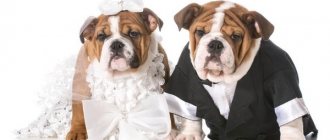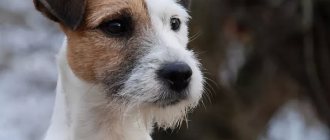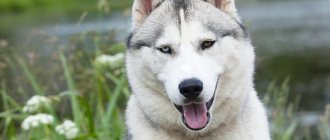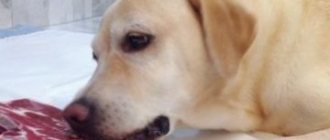The history of Labradors dates back to the 19th century.
During a trip to the island of Newfoundland, the English scientist Peter Hawker took several representatives of local dogs and from crossing with curly-haired retrievers and the English Foxhound, the Labrador appeared.
This breed is incredibly friendly and is widely used as guide dogs.
They are characterized by the same physiological processes as other breeds, in particular, estrus.
When do Labradors first go into heat?
This is a common question from many new Labrador puppy owners. As your Labrador bitch grows, there comes an age when your puppy begins to reach sexual maturity. His body is preparing for mating and the birth of puppies. This is known as the Labrador's first heat or first season.
For many dogs, this usually occurs around 6 months of age, but large breed dogs may begin the cycle later as their bodies grow and mature a little slowly. Therefore, a Labrador Retriever's first heat cycle can begin between 9 and 12 months of age.
But this is not the rule. I have seen Labradors who went into their first heat at 18 months of age. Some Labradors can be as much as 24 months late, and this depends on various factors including the dog's genetics.
Brief characteristics of the breed
The Labrador is a smart, kind and friendly dog that will become a devoted friend and a true family member. Has the following appearance features:
- The height of adult representatives of the species at the withers is 56-58 cm.
- The weight of females ranges from 25-32 kg, and males 27-36 kg.
- The color of the coat is always solid, but can be different: brown, black, fawn.
- In the nursery, the cost of a puppy with all documents ranges from $500 to $800*. Without documents, a puppy will cost a little more.
- A healthy dog lives about 11-13 years.
Labrador dogs are sociable and intelligent
The difficulties of keeping pets include the constant need for physical activity. You can't leave them alone at home for a long time. Out of boredom and loneliness, they will begin to spoil the owner’s things, causing significant damage to the property.
How often does a Labrador go into heat?
Just like a woman's monthly cycle, a Labrador's heat cycle follows a specific pattern in the same way. But this doesn't happen every month. Therefore, the Labrador's menstrual cycle is not a monthly process.
Most female Labradors come into heat every 6 months from the first season. In fact, a period of 6 to 8 months is considered normal.
But this is not the norm, and many lab bitches who begin their first season at the age of 1 year repeat the cycle only once each year. The occurrence of the estrus cycle is different for each dog. But in most cases this happens twice a year.
It would be helpful to have your veterinarian check your dog for deviations from these cyclic patterns. Irregular heat cycles and heat cycles that have been occurring recently should be reported to your veterinarian to check for the possibility of another underlying health problem.
© shutterstock
Either way, you'll become familiar with all aspects of heat once you fully understand the Labrador Retriever's heat cycle.
Basic rules of mating
Before mating, you must take the animal to a veterinary clinic and undergo a full examination.
The following tests must be taken:
- blood;
- vaginal smear.
The bitch is thoroughly treated for external parasites and dewormed. They take care of vaccinations in advance so that the bitch’s milk contains a sufficient amount of nutritional components.
A few weeks before mating, mineral supplements must be added to the diet.
Mating must be carried out on the territory of the male dog, since he must feel confident. A few hours before the process, the dogs are fed and walked. The owner must be present during mating.
Understanding the Heat Cycle of Labradors
The Labrador's hormonal cycle consists of 4 different phases. It is necessary to understand each phase to gain a complete understanding of your dog's heat cycle.
- The first stage or proestrus stage . The beginning of this stage indicates that your dog is preparing for pregnancy. At this stage, estrogen levels will be at their peak and male dogs will be very easily attracted to the bitch, but the bitch is not yet receptive to sex. You will notice physical signs such as swelling of the vulva and the beginning of bloody discharge from the vulva. This stage can last approximately 9 days or more.
- Fertile stage or estrus stage . This is the “Real Heat” stage. At this stage, your dog is fertile and follows his bodily instincts to mate. The level of estrogen in the body decreases, and the level of progesterone increases. Bloody discharge decreases and its color changes to straw. Because your dog is sexually receptive at this stage, he has a strong desire to mate and is constantly trying to find a mate.
- Diestrus stage . This stage occurs after the mating stage after the completion of the estrus stage. The discharge usually turns red again and finally stops at this point. Even though male dogs are still attracted to the female dog at this stage, your dog will no longer want to mate. This stage usually lasts 60-90 days or until the bitch gives birth (if pregnant). By the end of the diestrus stage, the hormonal levels return to normal and the dog enters the anestrus stage.
- The resting stage or anestrus stage . This is the stage of rest or lack of sexual activity. This stage means that your Labrador is not warm, which is why it is called the “No Warm” stage. Your dog is not sexually attractive to male dogs and mating does not occur at this stage. This resting stage lasts 3-4 months until the next heat occurs.
How long does a Labrador's heat last?
Although there is no exact number of days, a Labrador usually remains in heat for approximately 3-4 weeks. This includes the proestrus and oestrus stages, and the number of days for each individual stage varies from dog to dog.
Even if your Labrador is reluctant to mate during the initial stages of her heat, she becomes sexually receptive in the later days. Even though your dog remains in heat for 3-4 weeks, your dog remains at its most fertile for only a few days.
Approximately the most fertile period can begin 9-10 days after the start of the estrus cycle and last approximately 5 days.
Symptoms of a Labrador during heat
Monitoring your Labrador and observing her symptoms will help you determine if a heat cycle has begun.
Although the symptoms are not clear or obvious, a Labrador in heat will exhibit some symptoms that can be detected. These are symptoms you may notice during your Labrador Retriever's heat cycle.
- Enlarged vulva : This is one of the visible signs that your Labrador is in heat. The vulva appears swollen, and this can be recognized by normal observation.
- Bloody discharge : This is a sure sign that your dog has entered her heat cycle. The discharge appears red in the initial stages of estrus, later becomes straw-colored during the fertile stage and turns reddish again. Even though the amount of discharge in some dogs is much less, you may see blood stains either on your dog's bed or near his sleeping area.
- PMS in dogs . Just like female humans, dogs also have mood swings. Some dogs prefer to be left alone, while some dogs want more attention from their owners. This behavior varies from dog to dog.
- Excessive licking : Licking the genital area is a common behavior in dogs. But during estrus, this behavior may become excessive in order to remove his discharge.
- Swollen nipples : Hormonal changes can cause the nipples to become slightly enlarged. Although this is not an overt symptom, the symptom is slightly noticeable in some dogs.
- Tail movements : At the beginning of estrus, the dog tries to cover the vulva with its tail. This is called "tail tuck". Sometimes he sits on the ground simply to prevent males from coming nearby to mate. But when the bitch is preparing to mate, she diffuses her body odor by raising her tail and moving it from side to side. This is called "tail marking". Similar tail movements can be observed in your female Labrador during heat.
- Other behavioral changes . You may notice changes such as increased urination, nervousness, agitation, nesting behavior, picking up toys, and changes in appetite. These changes vary from dog to dog. Not all dogs exhibit all of these behavioral changes. Sometimes you may also observe your bitch mounting other dogs and people. This behavior is also observed in some dogs during heat.
- Flirting Males : Males are able to recognize a bitch in heat even from a distance. When your female dog is in heat, you watch male dogs roam around your house and yard. If you notice that a lot of male dogs are trying to hang around your female dog, this can be considered a clear sign that your dog is in heat.
© shutterstock
Features of caring for a dog in heat
During the cycle, the owner must pay increased attention to the animal, properly care for it and avoid visiting open water bodies. River water contains a large number of pathogenic microorganisms that can cause infectious diseases. It is not advisable to go for a walk to lakes and rivers - the dog can break out and swim without the owner’s permission.
How to control your dog during heat
The main control over the pet is carried out during walks:
- Walking takes place on a short leash - from the first day the females react poorly to commands and do not obey at all. Hormonal imbalance prevents them from soberly assessing the situation, which can provoke escape and search for a suitable sexual partner.
- Children should not go for walks - sometimes the dog will have to be restrained by force. Medium and large breeds easily pull out the leash and run away in an unknown direction. And when they return, they will “delight” the owner with the future offspring.
- Constant supervision - if you leave your pet alone in a special area or on the street, then nothing good can happen. A dog in a difficult psychological state requires constant presence and support from the owner.
- Reduced physical activity - if the animal was engaged in methods with serious loads, then it is better not to overexert it during the “problems”. Training will be in vain - at this time everything is subject to the influence of hormones, not the mind.
Important! When the first heat occurs, the owner must keep a special diary, where he will describe the duration and frequency of the cycle.
Taking notes will help you identify deviations in time, and if they exist, you can undergo diagnostics and begin treatment. If you have an idea to breed dogs, then the diary will also come in handy - it will help you calculate the favorable time for conception.
Walk control
How does a dog's behavior change during heat?
What changes should we expect? Hormonal imbalance causes the following symptoms:
- attempts to escape in order to find a potential partner;
- refusal or ignoring of commands, their reluctant execution;
- lack of response to the command “come to me” or “nearby”;
- decreased appetite;
- increased thirst.
Important! Unusual behavior is associated with hormonal imbalance. Do not force feed a pet that refuses food. Appetite will be restored by the end of the cycle.
How to keep dogs of different sexes
To reduce the risk of unwanted pregnancy, it is necessary to isolate the male from the female. Usually they are separated into different rooms, paying special attention to the period of 12-14 days of the cycle, when the probability of conception is highest.
Practice shows that keeping individuals of different sexes is possible without consequences, only if the rules are strictly followed:
- the girl is put on special underwear;
- prevent any contact between dogs;
- in difficult cases, means to reduce sexual desire are used.
Important! Where can you send a male dog: some owners prefer to send him to relatives. This approach is fraught with psychological trauma for pets - not everyone reacts adequately to a change in environment.
Temporary transfer to a cage
What about your Labrador's first heat and mating?
I have seen Labradors get pregnant during their very first heat. A Labrador is capable of mating during its first heat, but that doesn't mean it's a good idea.
During the Labrador's first season, although the dog is sexually active, it is not fully mature, either physically or biologically. Therefore, mating during the first heat in itself increases the risks associated with pregnancy and other health risks.
As a general rule, a female Labrador should not be bred until she is physically mature. Since our Labradors are classified as large breeds, they do not reach full maturity until 18-24 months.
Then what is the best age to breed Labradors? Considering the above factors, the ideal age for breeding would be around the third heat cycle.
Since breeding a dog comes with a lot of responsibility, it is best to avoid breeding during the first and second heat cycles.
Feeding
The Labrador Retriever is a tireless marathon runner and must be capable of long periods of work on land. And the need to swim in not always warm water requires the presence of a developed subcutaneous fat layer. Keeping warm also takes energy.
Therefore, by nature they are characterized by an excellent appetite. They eat as if they had enough left over for a week! Moreover, anything without being picky and sometimes deciding whether it can be eaten at all after the piece has fallen into the mouth.
A zucchini with legs is not a Labrador, but an unfortunate creature with shortness of breath and a bunch of chronic diseases. If you have a genetic tendency towards obesity, it is criminal to feed your dog!
The diet must be balanced: either natural food after consultation with a veterinarian, or good super-premium dry food. Plus active workouts to keep fit.
Since the breed's characteristics are omnivorous, hard vegetables and/or diced fruits work well as rewards. Reward is a small piece for flawless execution of a command, and not a kilo of carrots for beautiful eyes.
From an early age, do not spoil your baby with gastronomic delights!
If the Labrador is on dry food, one of the feedings can be moved outside. First, the hungry dog has a good run, and then he works on the skills of obedience, endurance, and sampling. Without barriers, fetch and other fuss - a calm workout, so that there is not the slightest risk from the gastrointestinal tract. You can’t eat or run, because we’re not talking about a treat, but about a full portion.
Prohibit households from feeding the puppy from the table. Explain that he is not a trash can or a starving refugee from Africa. This is true for any breed, but Labras are perhaps one of the most gluttonous, along with Dachshunds. And it’s almost impossible to stop them from eating everything.











